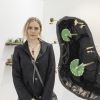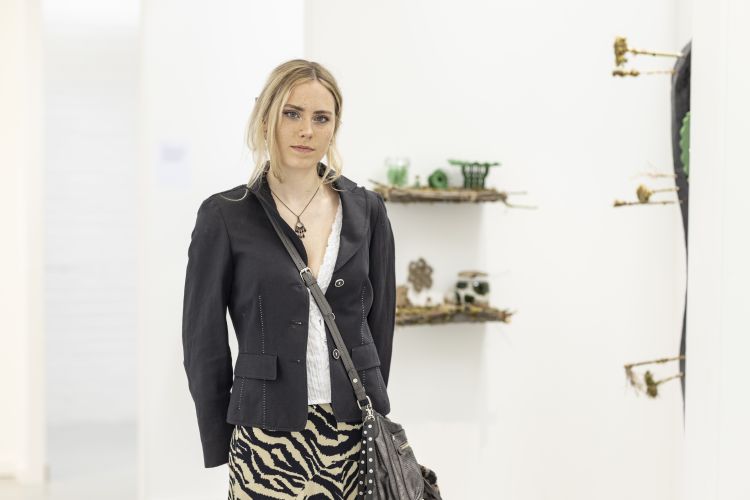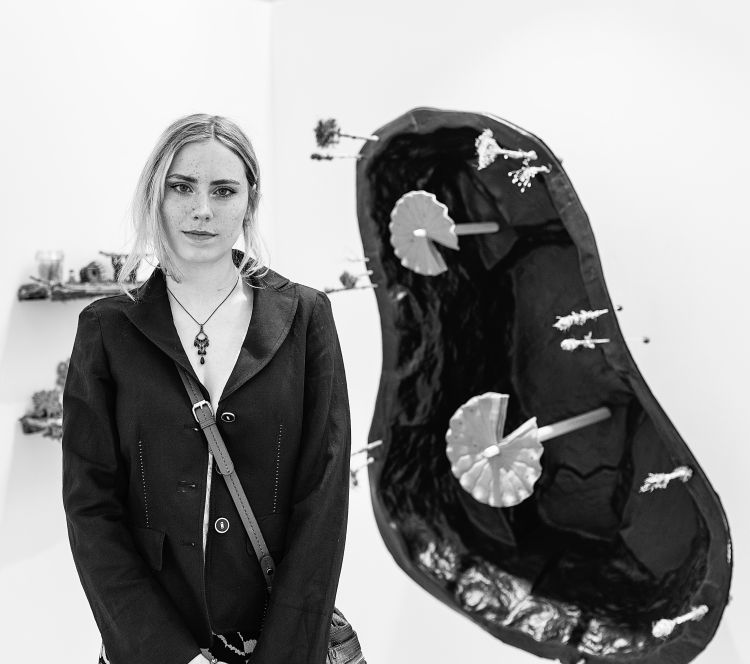
Emily Taylor-West
- Course: Art and Design BA
What made you want to apply to your course and to Leeds?
After graduating from Oxford Brookes University with a foundation diploma in Art and Design, I wanted to continue this course as a bachelor’s degree due to flexibility regarding the selection of my core discipline. Additionally, I wanted to become a part of a prestigious university to improve my academic confidence, particularly in writing. This course consistently engaged in a myriad of writing tasks, particularly the final year dissertation which was vital to my development as an independent researcher.
I also wanted to apply to this course after seeing the facility placement, being that it was directly on campus compared to many other Russell group universities which tend to neglect the arts and situate creative courses on the outskirts of their campuses. Whilst I understand this may not be a concern for many, being placed at the heart of the community made me feel more accepted as a student that was not studying a STEM course.
What aspects of the course do you enjoy the most?
As the main module ‘Creative Practice’ is split into two assessments, essay and portfolio, this separation allowed me to develop my critical thinking skills to assess the development of each project through writing, an element that I have always enjoyed.
Although the dissertation was daunting, I believe that this assignment truly enhanced my writing skills.
Each lecture is tailored by one of the three academic tutors within our Creative Practice module. These are engaging, informative presentations that help influence methods to approach each design project.
How has your experience been with the facilities, the staff, your peers and the student union?
All of the facilities have been outstanding, you are able to access more than you are aware of, so it is always good to ask if a certain niche is available. For example, I was always interested in resin printing and found out that these high-tech printers are placed within the 3D printing workshop hosted by Gareth Griffiths, an amazing and supportive technician that helped me to develop my digital sculpting skills throughout my degree.
What I liked most about studying art and design was being able to have our own spaces to study in. Although it is enjoyable to visit the university libraries, these facilities can become busy and require you to visit early to secure a seat throughout the day. Having a blank space with highlighting and plug sockets gives you the perfect environment to thrive in.
The staff here are highly skilled in their professions but also know how to support us and make our creative voices feel seen and heard, a vital part that built my confidence in my practice. The most important aspect of this course is tutor rota, providing us with the opportunity to discuss our ideas to a different tutor each week. This allows us to receive new dialogue for the project whilst ensuring that our practice is independently motivated.
Finally, words cannot describe how much the student union provided a positive and safe environment for me and my friends. This is by far one of the best university unions I have seen. The layout is easy to navigate, the colours are bright and inviting, and they have just about every food option you can think of. It is a great place for students to gather and relax but also an area for studying and even partying with the student club, The Pyramid, situated underground the facility!
What other activities are available for students to take part in outside of their studies and which ones have you tried out yourself?
Before attending the University of Leeds, I had never listened to rock/heavy metal music, however, the Leeds Rock Society was introduced to me during the society fair in my first semester. Initially, I thought that a sport society would be something of interest, but as there was a plethora of alternative choices, it became an interesting opportunity to try something new. This experience led to two consecutive years of being a member of the Rock Society, an unforgettable time that allowed me to experience a new culture and make lifelong friends that I still go to heavy metal festivals with today!

What do you think of Leeds and the surrounding region? Where is your favourite place to go in the area?
There are a wide variety of places surrounding Leeds that are beautiful. For areas close to Leeds, my favourites are: Roundhay Park, Rodley Nature Reserve, Kirkstall Abbey, The Harewood House Trust, Yorkshire Sculpture Park, Tropical World.
Further out: Ilkley, York, Whitby, Manchester
Specifically: Ilkley Manor House, York Minster and Museum Gardens, Whitby Abbey and Beach.
Do you live in student accommodation or a shared house, if so what is that like?
In year one, I lived in Charles Morris. Situated on the university campus, I found that everyone was so welcoming. The location was amazing, especially as someone who has struggled with time management and gets easily overstimulated as it gave ample time to arrive to lectures 15 minutes in advance for myself to prepare for them.
In my second-year accommodation, I moved to Chestnut Avenue near the Hyde Park Picture House. This was a 16-minute walk from campus; however, the street was on a main road and the buildings faced it, making for busy evenings but a challenging sleeping experience. When choosing a student house, be aware of the surroundings to suit your needs and wants.
The main advice taken from living at the University of Leeds is to not succumb to the pressure of making a group and finding a house in a rush. Although everyone stresses this, you will still be able to find a good house. Don’t panic and do what is right for you!
Was there anything you felt daunting in the lead-up to attending university that you have overcome?
Being a student that had already completed a foundation degree, I was worried about feeling too old (which I have noticed is a common thought for mature students), however, many of the students were also my age and some older than me. Most importantly, they were all great people to live with.
How do you think the skills and knowledge you’ve developed at Leeds will help with your career plans?
Not only did this university improve my confidence and efficiency in writing due to most of the modules requiring essays and a dissertation for the final year, but it also encouraged me to explore different avenues of design before selecting sustainable product design.
The technicians were of the most importance within the first year as they welcomed everyone to learn more about specific disciplines such as 3D printing, casting or RISO printing. By attending workshops provided, I found my interest in 3D sculpting and printing digitally thanks to both Gareth Griffiths and Eleanor Rambellas Roche.
As the school of design often blends lectures with students from different courses, I was able to make friends with people that had a myriad of skill sets, which provided me with people to reach out to when I was needing advice or assistance with the best software to use for certain tasks.
Tell us about some of the exciting projects you have completed on your course
In the first semester of year one, I decided to research into the harmful ecological effects of burial industries. This led to the discovery of mycelium coffins which gradually biodegrade and enrich the soil. This was the highest achieving grade within my Design History Design Futures module, achieving a 82! I enjoyed this topic so much that it became one of the Creative Practice topics during semester one of year two, developing a new alternative to traditional burial methods called ‘The Poppy Bulb Capsule.’
Like the natural spreading of seeds from the chamber of poppy bulbs, this sustainable product design engages in biomimicry combined with a modern cremation method called ‘Alkaline Hydrolysis’ or commonly known as water cremation. By using less energy and cutting out the CO2 emissions caused by traditional cremation, the ashes would be harbored within the bulb formed from an emulsion of paper pulp and sphagnum moss, allowing a natural dispersal of the ashes that eliminate the challenge of spreading them, particularly during high wind; an experience that many fear as it can fall back onto their loved ones instead of being placed in the intended location.
After a brief hiatus from sustainable product design, my final semester of Level 3 investigated the concept of posthumanism. This idea can be identified as a mode of thinking that situates itself on the other side of humanism. Therefore, my project focused on designing for the benefit of the earth over human beings. That being said, by implementing this idea, it would eventually circumvent and benefit us as the earth is rejuvenated.
LiLi became the final prototype, a biomimetic, bio-filtration device capable of reducing and removing harmful algae blooms within closed wetland systems, lakes and ponds. The design mimicked native water lilies and contained a hanging basket below to accommodate micro and macro invertebrates, boosting aquatic wildlife populations which also increase water quality as they filter the water themselves. LiLi would not require filtration replacements (which is common within current lake filters), making the design a non-invasive posthumanism product.
Finally, what made this project so exciting was the use of algae-based printing filament for LiLi’s surface structure. This 3D printing material is a more sustainable option compared to traditional PLA (polylactide) filament. By implementing this material, LiLi engages in circular design as the algae from this filament is collected and filtered from harmful blooms within lakes and cuts down the use of PLA in half.
What are your ambitions for the future?
Finding a way to incorporate 3D printing into my practice, hopefully conducting research within a product design company that is sustainably driven. Alongside this, I would love to volunteer in wetland conservation management, or anything related to wildlife protection.
Additionally, it would be amazing to become an art teacher and educate students about sustainability awareness. I have always been keen since becoming a nursery assistant to pre-school children.


